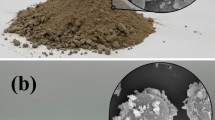Abstract
Cement and lime are widely employed in soil and sediment treatment for an improvement of geotechnical properties, such as an increase in mechanical strength which enables beneficial use in various geotechnical applications. In this study, fine organic-rich dredged harbour sediments of 120% relative water content were treated with dry cement at contents varying between 2% and 10% of bulk sediment wet weight. Tests based on assessments of one-dimensional compression and Atterberg limits were performed on untreated and cement-treated sediments for various curing periods, as well as grain-size, SEM and X-ray diffraction analyses. The results confirm that increasing the cement content improves the geotechnical properties of these harbour sediments. Already in the early phase of curing (first 3 days of curing), particle size increases while sediment plasticity decreases. Changes in the compressibility behaviour include an increase in apparent preconsolidation pressure, in the compression index C c and in the primary consolidation coefficient C v, and a decrease in the secondary compression index \( C_\alpha \). This means that the new materials are characterized by a behaviour intermediate between that of fine and that of coarser soils.








Similar content being viewed by others
References
Boutouil M (1998) Traitement des vases de dragage par solidification/stabilisation à base de ciment et additifs. PhD Thesis, Le Havre University
Boutouil M, Levacher D (2005) Effect of high initial water content on cement based treated sludge solidification. Ground Improvement 9(4):169–174
Chew SH, Kamruzzaman HM, Lee FH (2004) Physicochemical and engineering behaviour of cement treated clays. J Geotech Geoenviron Eng 130(7):696–706
Colin D (2003) Valorisation des sédiments fins de dragage en technique routière. PhD Thesis, Caen University
Dermatas D, Dutko P, Balorda-Barone J, Moon DH (2003) Evaluation of engineering properties of cement treated Hudson River dredged sediments for use as fill material. J Mar Environ Eng 7(2):101–123
Feng TW, Lee JY, Lee YJ (2001) Consolidation behaviour of a soft mud treated with small cement content. Eng Geol 59:327–335
Holtz RD, Kovacs WD, Lafleur J (1996) Introduction à la géotechnique. Polytechnic School of Montréal
Kamali S, Bernard F, Abriak NE, Degrugilliers P (2008) Marine dredged sediments as new materials resource for road construction. Waste Manage 28:919–928
Le Roux A (1969) Contribution à l’étude du traitement à la chaux des matériaux argileux. PhD Thesis, Paris XI University
Locat J, Bérubé MA, Choquette M (1990) Laboratory investigations on the lime stabilization of sensitive clays: shear strength development. Can Geotech J 27:294–304
Locat J, Tremblay H, Leroueil S (1996) Mechanical and hydraulic behaviour of a soft inorganic clay treated with lime. Can Geotech J 33:654–669
Lorenzo GA, Bergado DT (2004) Fundamental parameters of cement admixed clay; new approach. J Geotech Geoenviron Eng 130(10):1042–1050
Mitchell JK (1993) Fundamentals of soil behaviour. Wiley, New York
Perret P (1977) Contribution à l’étude de la stabilisation des sols fins par la chaux. Etude globale du phénomène et applications. PhD Thesis, INSA Rennes
Pollard SJT, Montgomery DM, Sollars CJ, Perry R (1991) Organic compounds in the cement-based stabilization/solidification of hazardous mixed wastes: mechanistic sand process considerations. J Hazard Mater 28:313–327
Rashid MA, Brown JD (1975) Influence of marine organic compounds on the engineering properties of a remoulded sediment. Eng Geol 9:141–154
Rekik B (2007) Propriétés géotechniques des sédiments de dragage traités au ciment. PhD Thesis, Caen University
Rekik B, Boutouil M (2008) Organic matter and cement contents effects on geotechnical properties of cement treated sediments. In: Abriak NE, Damidot D, Zentar R (eds) Proc Int Symp Sediment Management, 9–11 July 2008, Lille, France. Ecole des mines de Douai/I2SM, Lille, pp 225–233
Stevenson FG (1994) Humus chemistry: genesis, composition, reactions, 2nd edn. Wiley, New York
Terzaghi K, Peck RB (1967) Soil mechanics in engineering practice, 2nd edn. Wiley, New York
Tremblay H, Leroueil S, Locat J (2001) Mechanical improvement and vertical yield stress prediction of clayey soils from eastern Canada treated with lime or cement. Can Geotech J 38:567–579
Tremblay H, Leroueil S, Locat J (2002) Influence of the nature of organic matter on the soil stabilization with cement. Can Geotech J 39:535–546
Author information
Authors and Affiliations
Corresponding author
Rights and permissions
About this article
Cite this article
Rekik, B., Boutouil, M. Geotechnical properties of dredged marine sediments treated at high water/cement ratio. Geo-Mar Lett 29, 171–179 (2009). https://doi.org/10.1007/s00367-009-0134-x
Received:
Accepted:
Published:
Issue Date:
DOI: https://doi.org/10.1007/s00367-009-0134-x




